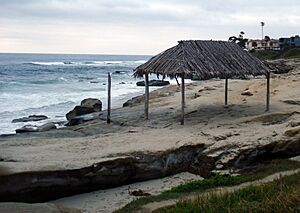Windansea Beach facts for kids
Quick facts for kids Windansea Beach |
|
|---|---|

A wide picture of Windansea Beach in 2018
|
|
| Location | San Diego, California |
Windansea Beach is a famous stretch of coastline in the La Jolla area of San Diego, California. The neighborhood next to the beach is also called Windansea. The beach got its name from the "Windansea" Hotel, which was named in 1919 after a contest. This hotel burned down in 1943. The beach itself stretches along the coast between Palomar Avenue and Westbourne Street.
Contents
Catching Waves: Surf Breaks at Windansea
The main surfing spot at Windansea is a "reef break." This means the waves break over a rocky area near the shore. In the winter, the waves at Windansea can get quite big, sometimes six to eight feet tall! Other popular surf spots nearby include Middles, Turtles, Simmons, and Big Rock. Simmons is named after a surfer named Bob Simmons, who sadly passed away there in 1954.
The Famous Windansea Surf Shack
A special landmark at Windansea is a small shack covered with palm leaves. Surfers built it in 1947 to have a shady spot. It helped keep the wax on their surfboards from melting. It also gave their families a place to relax out of the sun. The first shack was made from eucalyptus branches, then later from bigger branches and palm fronds.
The shack has been rebuilt a few times. A big storm knocked it down in 2003, and huge waves destroyed it again in 2015. But locals always rebuilt it! In 1998, "The Surf Shack at Windansea Beach" was officially named a historical landmark. A plaque on the shack says it was "built by returning World War II surfers in 1947 for shade and aloha."
Beach Access and Facilities
The Windansea parking lot is on Neptune Place, between Nautilus and Bonair Streets. It has a limited number of parking spots. You can usually find more parking along the street. It's good to know that there are no drinking fountains, showers, or public restrooms at this beach.
Windansea's Surfing History
Windansea Beach has a rich history in the surfing world. Many famous surfers have called it their home break. These include Mickey Munoz and Butch Van Artsdalen. In the early 1960s, one magazine publisher called the Windansea surfers "the heaviest surf crew ever."
The Windansea Surf Club was started in 1963 by Chuck Hasley. This was to get ready for a big surf competition. Famous surfers like Mike Hynson, who was in the movie The Endless Summer, were founding members.
In 1963, artists Michael Dormer and Lee Teacher built a large, heavy statue called Hot Curl. It was a cartoon character holding a beer and looking for waves. This statue appeared on the rocks at Windansea beach. Hot Curl even appeared in the 1964 movie "Muscle Beach Party"!
For many years, Windansea was known for being a very exclusive surf spot. Sometimes, surfers who weren't from the area faced problems. But by the 1990s, this behavior had mostly stopped.
Windansea in Books and Music
Windansea Beach has appeared in popular culture. The title story in Tom Wolfe's book The Pump House Gang is about a group of surfers from Windansea.
The Christian rock band Dakoda Motor Co. named their 1993 song "Wind 'an' Sea" after this community.


